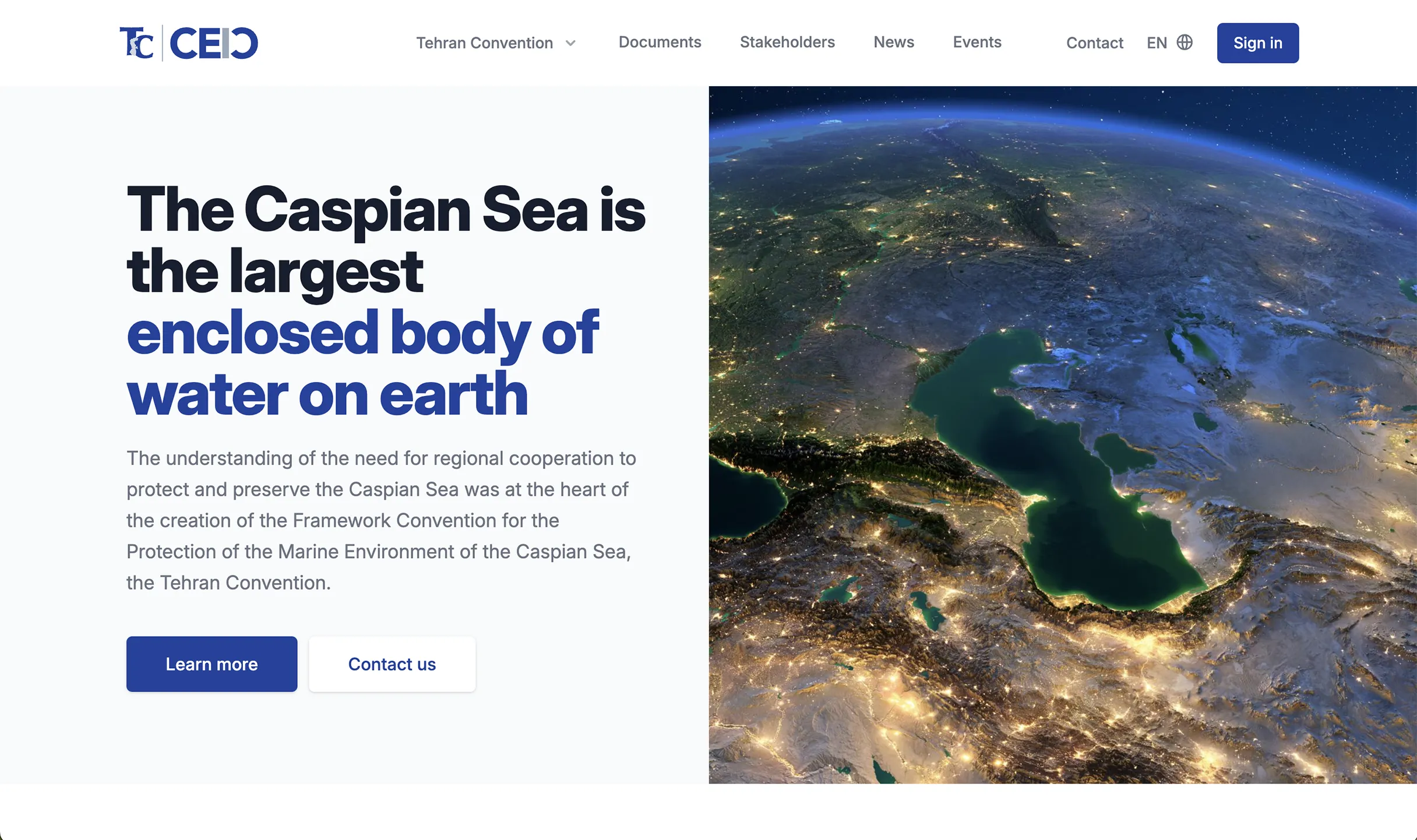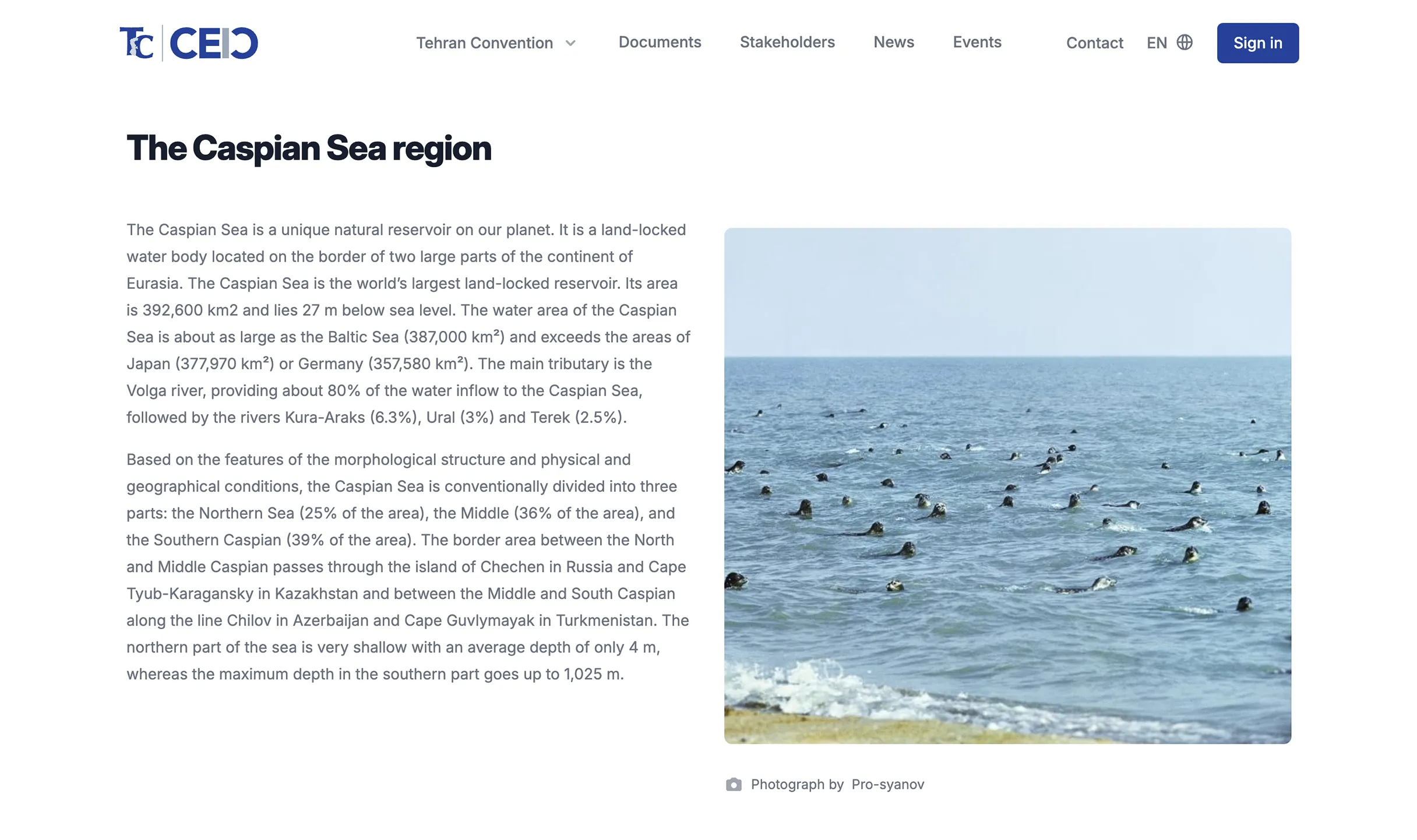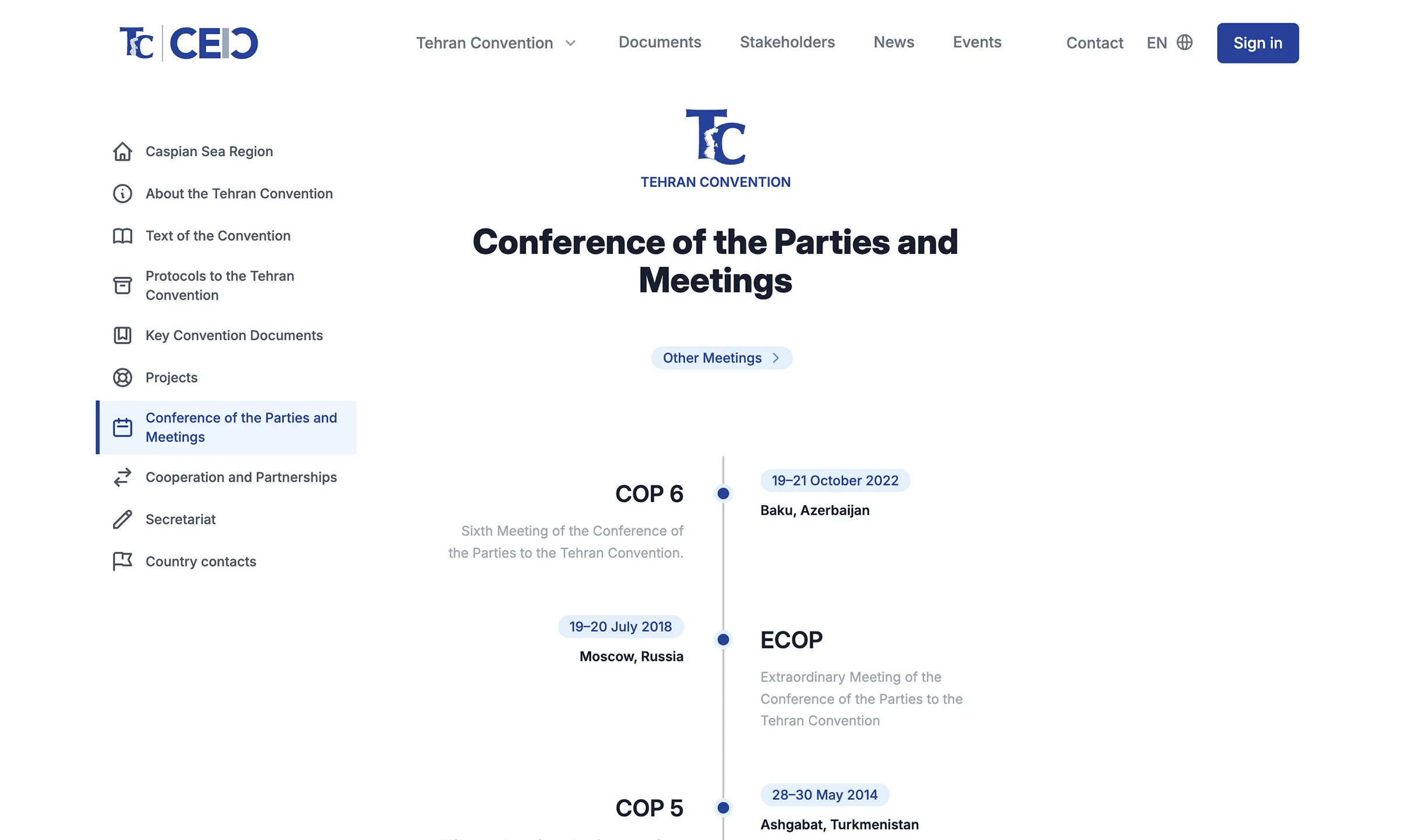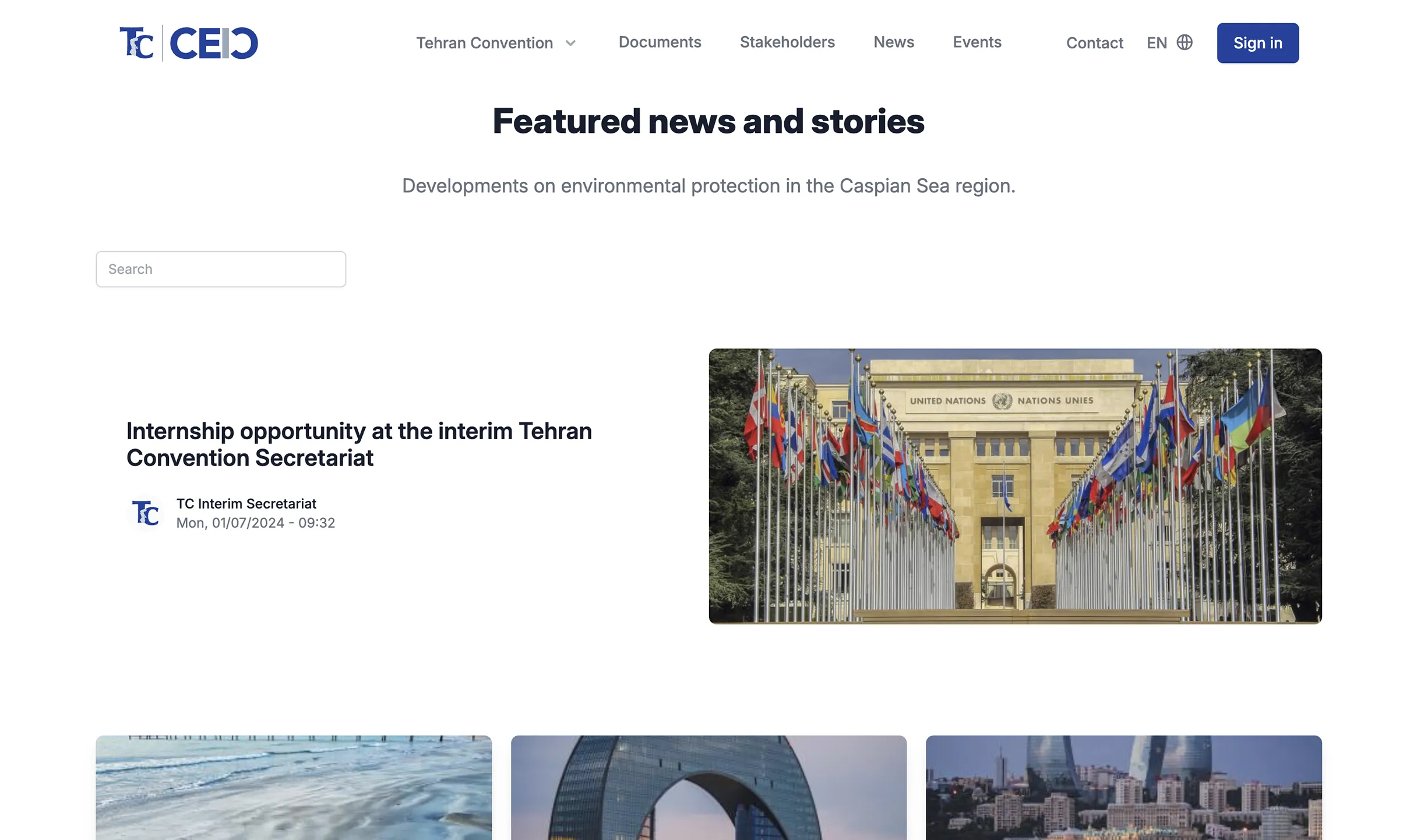Case Study
Empowering Collaboration: Transforming the Tehran Convention's Digital Platform for the Caspian Sea
“The collaborative tools implemented by the team significantly improved our ability to communicate and share information across the Caspian countries. The platform is now more accessible and user-friendly, which has led to greater participation and engagement in our meetings and forums.”

The Tehran Convention is dedicated to the Framework Convention for the Protection of the Marine Environment of the Caspian Sea. It focuses on promoting environmental protection and sustainable development in the Caspian Sea region. The website features information on the history and text of the Convention, thematic protocols, ongoing projects, meetings, and cooperation efforts. It also includes news updates, documents, and contact details for national focal points and the secretariat, administered by the UN Environment Programme.
The primary goal was to enhance the collaborative capabilities of the Tehran Convention website, focusing on unifying organizations across the five Caspian countries to facilitate content creation, information sharing, and improved organization of meetings and forums. BlueMelon aimed to develop a collaborative tool to streamline communication and data sharing among Caspian countries, enhance the user interface and experience, integrate a robust CMS to support the Convention's dynamic needs, improve the organization of meetings and forums, and ensure the platform supports multilingual content for the diverse linguistic needs of the region.
The Challenge
The project faced several unique challenges. Unifying organizations from five different countries, each with its own set of regulations, languages, and workflows, was a significant hurdle. Additionally, managing a vast amount of data, including historical documents, ongoing projects, and meeting records, while ensuring data accuracy and security, was crucial.
Creating a user-friendly platform that catered to users with varying levels of technical proficiency and access to resources was essential. Providing comprehensive multilingual support to accommodate the primary languages spoken in the Caspian region and enabling real-time collaboration and communication among stakeholders spread across different time zones were also critical challenges.

The Solution
To address the challenges, the project utilized Drupal 9 with the Drupal Media and Group modules to build a tailor-made communication and document management system. The front-end development leveraged Alpine.JS and TailwindCSS to create intuitive and easy-to-use interfaces. This combination ensured that the platform was not only functional but also user-friendly.
Drupal 9, Drupal Media, and Group Modules Configuration and Customization:
- Drupal 9: Chosen for its robust content management capabilities and flexibility, Drupal 9 provided the backbone for the website and intranet. It allowed for extensive customization to meet the unique needs of the project.
- Drupal Media: This module was essential for managing and organizing media assets across the platform. It supported a wide range of media types and provided the necessary tools for categorizing and retrieving media efficiently.
- Group Module: This module facilitated the creation of distinct working groups within the platform. Each group could manage its own content and users independently, which was crucial for handling the sensitive and varied needs of different organizations involved in the Convention.
- Custom Workflow: A custom workflow was built to ensure that only approved content was published on the public website. Given the sensitive political situation in the region, this workflow included multiple approval stages and permissions to ensure that content was vetted thoroughly before going live. This approach minimized the risk of publishing politically sensitive or incorrect information.
Alpine.JS and TailwindCSS for Usability:
- Alpine.JS: Selected for its simplicity and flexibility, Alpine.JS allowed for the creation of dynamic and interactive components without the overhead of a larger framework. It enabled the development of custom features, such as drag-and-drop functionality, which enhanced the user experience by allowing users to easily move documents and information across different working groups.
- TailwindCSS: This utility-first CSS framework was used to create a responsive and consistent design across the platform. TailwindCSS made it easy to implement custom styles and ensured that the user interface was both attractive and functional. The combination of Alpine.JS and TailwindCSS contributed significantly to the platform’s overall usability, making it intuitive and easy to navigate for users with varying levels of technical expertise.

Implementation
The implementation process began with initial user research to gather requirements and preferences. This informed the design of a responsive UI/UX, improving accessibility and ease of use. The platform was developed using Drupal 9, leveraging the Drupal Media and Group modules for robust content and document management. Alpine.JS and TailwindCSS were integrated for dynamic and user-friendly front-end development.
Advanced data management and security protocols were implemented to protect sensitive information. Multilingual support was added using a translation management system, and scheduling and event management tools were deployed. The platform was launched in phases to ensure smooth adoption and transition, allowing stakeholders to gradually adjust to the new system and providing opportunities for feedback and refinement.

The Results
The implementation of these solutions led to significant improvements. The new collaborative tools facilitated better communication and cooperation among the organizations in the five Caspian countries, with real-time data sharing and document editing improving workflow efficiency. The redesigned interface and enhanced UX features led to a 40% increase in user engagement and satisfaction, ensuring inclusivity for all users.
The structured data management system improved the organization and retrieval of documents, with enhanced security measures ensuring the protection of sensitive information. Multilingual support expanded the reach of the platform, making it accessible to a broader audience and enabling seamless language switching for better understanding and participation. The event management tools optimized the planning and execution of meetings and forums, with comprehensive documentation and sharing capabilities facilitating better follow-up and implementation of decisions.

Scope of work
Comprehensive Project Description
This comprehensive approach ensured that the Tehran Convention website not only met the immediate needs of the stakeholders but also provided a scalable and sustainable solution for future growth and collaboration.
- Development of a multilingual website
Using Drupal 9 with Drupal Media and Group modules to build a comprehensive communication and document management system.
- Implementation of collaboration and communication tools
Integrated within the Drupal CMS to enhance interaction among member countries.
- Design and development of user-friendly interfaces
Utilizing Alpine.JS and TailwindCSS to create intuitive and responsive designs.
- Setup of a centralized database
For efficient and secure data management within Drupal.
- Coordination of translation services
Ensuring comprehensive multilingual support through Drupal’s built-in capabilities.
- Unified user experience
Seamless integration of the public website and the intranet part of the same website to provide a consistent and user-friendly experience.
More Case Studies
Explore our latest success stories and innovative solutions.
